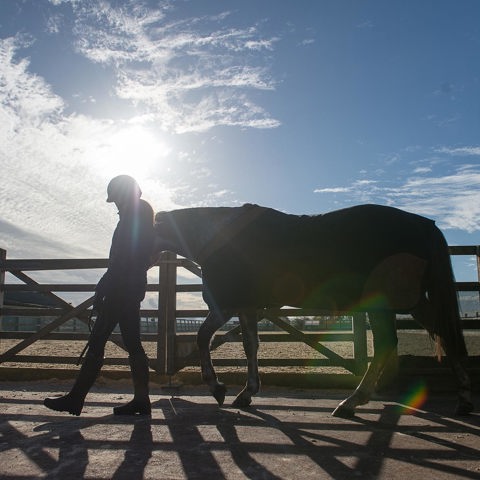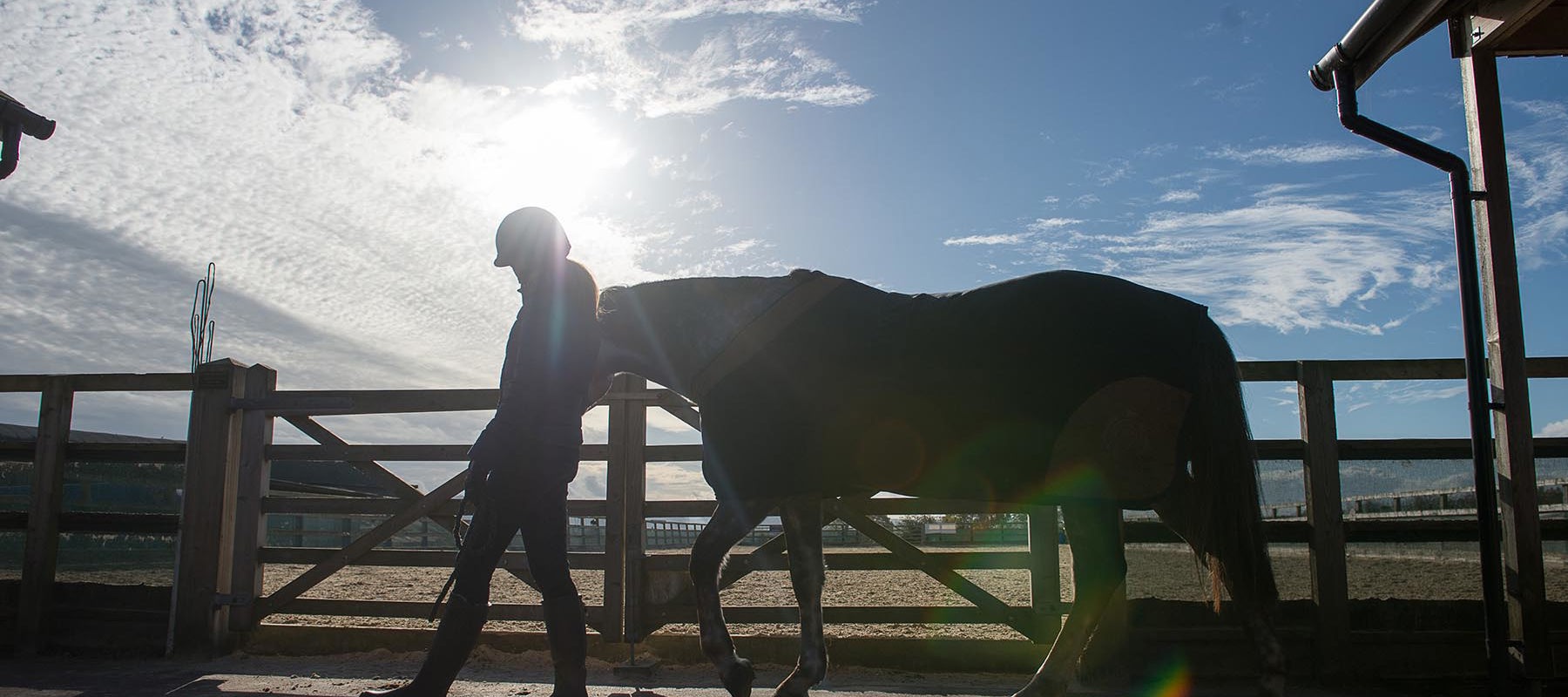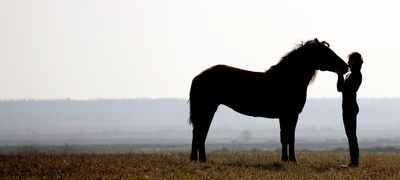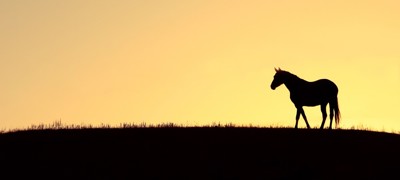There are many reasons why a horse may have to be euthanised, including illness, an accident, change in owner’s circumstances or because old age or a pre-existing condition has led to their quality of life deteriorating. The BHS has empathy for the difficult decision involved with euthanasia and offers a free Friends at the End support scheme.
It’s important for horse owners to be aware that due to serious injury or illness, euthanasia may have to be opted for unexpectedly in horses of any age. Dealing with an emergency is difficult enough, without having to make some very hard decisions quickly and under pressure. By being prepared and understanding the processes and options available, making an appropriate plan will help to make a difficult decision a little easier in a stressful situation.
For euthanasia and quality of life advice related to donkeys, visit The Donkey Sanctuary.
Friends at the End
Providing the right care at the end of a horse’s life is the last, and possibly greatest, thing we can do for them. The BHS Horse Care and Welfare team is always willing to talk to owners about euthanasia and provide any information, advice and support that may be needed at a difficult time, with our Friends at the End support scheme.
When and why?
Every situation is different and veterinary or professional advice should always be sought. The unfortunate reality is that very few horses pass away peacefully due to old age. For many horses, the decision to euthanise will need to be taken when their quality of life deteriorates. However, it’s not always easy to assess quality of life, particularly if you see your horse every day.
You can download and use our emergency plan in order to prepare and consider how you would like your horse to be euthanised. Make sure that your yard owner or a friend has access to this plan in case you can’t be contacted in the event of an emergency.
Should you be present?
Many people feel that they want to be with their horse in their final moments. Your horse will be in the hands of an experienced professional that will carry out the procedure with everyone’s safety being paramount. It may be helpful to have a family member or a friend in attendance who will be able to stay with you after your horse has gone. The process can be distressing for the owner and the professionals involved will understand if you don’t wish to be present. Our Friends at the End support scheme also provides the opportunity of a trained, experienced BHS Friend to be present and help provide support on the day
Euthanasia methods
The euthanasia of any animal can be very upsetting or distressing for their owner. The information below describes what will happen to a horse during the process, so that you are prepared if you wish to remain with your horse and to help with the decision-making process of what type of euthanasia method you’d prefer to opt for.
Euthanasia by lethal injection
chevron-down
chevron-up
The lethal injection can only be administered by a veterinary surgeon. In some cases, the horse may be sedated beforehand. The injection consists of an overdose of anaesthetic drugs which causes the horse to collapse, experiencing a rapid loss of consciousness followed by the heart stopping. Occasionally the horse may take 2-3 gasps of breath following collapse and loss of consciousness, which is a common and involuntary nervous system response to the euthanasia drugs. It may take a short time (60-90 seconds) for the heart to stop, and there may be some involuntary muscle twitching or leg movement which can prove distressing to the owner. However, the horse will not be conscious during this time and is completely unaware of what is going on and won’t be in any pain. The vet will monitor the horse’s pulse until it has stopped.
Once the injection is administered, the horse will tend to fall quite slowly, but this can be unpredictable meaning that the safety of the vet and handler must be considered. A skilled handler can influence the direction in which the horse falls. Many vets will allow the owner to hold the horse, if they wish to, while the injection is given, but will then take hold of the horse and ask the owner to stand back, giving plenty of space.
Euthanasia by free bullet
chevron-down
chevron-up
This must be carried out by a vet or other licensed professional. In some cases, the horse may be sedated and this can only be administered by the vet if given by injection. The muzzle of the gun is placed against the horse’s forehead and the bullet discharged, this will euthanise the horse instantly with them falling to the ground. The horse’s limbs may make sudden twitches; these are normal reflexes after death, and the heart will still beat for a short while even though there is a loss of consciousness. The noise of the gun shot will be of no detriment to the horse who would’ve been completely unaware as the process will be instant. Once the horse is on the ground, blood may be discharged from the wound in addition to the nose and/or ears and the amount can vary between individuals.
Where and what happens afterwards?
In some cases, it may not be possible to have your horse euthanised at home however it’s very important to make sure that your horse is physically and mentally able to travel. A vet will need to determine whether the horse is fit for travel and if it’s appropriate to do so. This should only be considered if your horse is used to being loaded and travelled, the distance should also be short and their welfare during transportation of the upmost importance.
It’s important to consider the location for euthanising the horse, as vehicle access will be required, however in an emergency, this may not be possible. The welfare of the horse shouldn’t be compromised in order to move them to a convenient site. Ideally euthanasia should be carried out in familiar surroundings with all other horses removed. If there is a closely bonded pair, it may be beneficial after the horse has been put to sleep that the other horse can see their friend. This can help the horse understand the situation and reduce their stress levels caused by the absence of their companion but this should be judged based on the individual1.
After a horse has been euthanised, there are several options for the collection of your horse’s body. However, some options have limitations depending on the method of euthanasia used and the cost can vary considerably.
Burial
chevron-down
chevron-up
In Scotland, Wales and Northern Ireland only pet horses are allowed to be buried, in England a horse can be buried whether they’re a pet or not. However, it’s essential to seek advice from your local animal health office or national agricultural department before burial2. Regulations vary between local authorities, but if the site of burial is near to a water source, then advice should be sought and guidance followed3. This would need to be planned in advance as permission can take some time to obtain
Cremation
chevron-down
chevron-up
Most equine crematoriums will collect the horse after they’ve been euthanised. Group cremation is less expensive than individual, but an individual cremation does give the owner the option of having some, or all, of their horse’s ashes returned.
The Equine End of Life Service
chevron-down
chevron-up
The Equine End of Life Service help facilitate horse euthanasia and/or a collection service for the deceased horse, pony or donkey, utilising fully trained, professional and licensed collectors.
Hunts and abattoirs
Many hunts offer euthanasia (by free bullet) and a collection service, although it’s important to note that this may not be available immediately in an emergency situation.
Abattoirs which handle equines could be an option that some owners consider as there is often no cost. For your horse to be accepted by an abattoir they must be able to comfortably travel, therefore emergency situations and horses with chronic conditions or injuries would not be suitable for this option.
Arrangements for collection
Removing the horse’s body from the site of euthanasia can be distressing for those who have been involved with the horse during their lifetime. If you don’t feel able to be there then that’s okay and you shouldn’t feel guilty about the decision - it can be a very emotional and difficult situation to witness. Your vet may have some contacts for local, licensed collection services and will be able to advise you further.
Passport
After the death of a horse, you’re legally required to inform the relevant Passport Issuing Organisation (PIO) and return the passport to them within 30 days. Many PIOs will return the passport to you afterwards if you request it as a keepsake.
Insurance
If your horse is insured, it’s important to be clear exactly what the policy covers if euthanasia is required. The level of cover varies greatly with different policies and in many cases, only a contribution will be made towards the costs involved. The rest of the expense must be met by the horse owner. If your horse is being euthanised for non-emergency reasons, it’s important to contact your insurance company before you go ahead. For example, if an owner elects euthanasia for their horse which has a chronic condition, such as arthritis, and the horse doesn’t satisfy the BEVA guidelines, insurance companies can refuse to pay out. There may also be circumstances where the insurance company requests that a post-mortem is completed.
If your horse has been euthanised because of an emergency, you should contact your insurance company as soon as possible afterwards. In an emergency the euthanasia of a horse should never be delayed for insurance purposes.

Thanks to the British Equine Veterinary Association for their support in the production of this advice.
References
- Mendonça, R. S., et al., (2020) Feral horses' (Equus ferus caballus) behavior toward dying and dead conspecifics..
- UK. (2023) Keeping Horses.
- UK. (2022) Animal Burials: prevent groundwater pollution.
Get in touch – we’re here to help
The Horse Care and Welfare Team are here to help and can offer you further advice with any questions you may have. Contact us on 02476 840517* or email welfare@bhs.org.uk – You can also get in touch with us via our social media channels.
Opening times are 8:35 am - 5 pm from Monday – Thursday and 8:35 am - 3 pm on Friday.
*Calls may be recorded for monitoring purposes.




